Effects of Ethanol on the Supercritical Carbon Dioxide Extraction of Cannabinoids from Near Equimolar (THC and CBD Balanced) Cannabis Flower
Abstract
:1. Introduction
2. Materials and Methods
2.1. Chemicals and Reagents
2.2. Sample Preparation
2.3. SFE Equipment and Setup
2.4. SFE Conditions
3. CO2 Extraction with Co-Solvent
3.1. Conventional Extraction
3.2. Statistical Analysis of the Experimental Design
4. HPLC Quantification
4.1. Mobile Phase Elution Program
4.2. Standard Solution Preparation
4.3. Sample Preparation for Cannabinoid Quantification
5. Results and Discussion
5.1. Effect of scCO2 Density on the Extraction of Cannabinoids
5.2. Effects of Pressure and Temperature
5.3. Effects of Co-Solvent
5.4. SFE vs. Organic Solvent Extraction
6. Conclusions
Author Contributions
Funding
Acknowledgments
Conflicts of Interest
References
- Campone, L.; Celano, R.; Piccinelli, A.L.; Pagano, I.; Carabetta, S.; Di Sanzo, R.; Russo, M.; Ibañez, E.; Cifuentes, A.; Rastrelli, L. Response surface methodology to optimize supercritical carbon dioxide/co-solvent extraction of brown onion skin by-product as source of nutraceutical compounds. Food Chem. 2018, 269, 495–502. [Google Scholar] [CrossRef] [Green Version]
- Abbas, K.A.; Mohamed, A.; Abdulamir, A.; Abas, H. A review on supercritical fluid extraction as new analytical method, American. J. Biochem. Biotechnol. 2008, 4, 345–353. [Google Scholar]
- Espinosa, S.; Diaz, M.; Brignole, E. Process optimization for supercritical concentration of orange peel oil. Lat. Am. Appl. Res. 2005, 35, 321–326. [Google Scholar]
- Khaw, K.-Y.; Parat, M.-O.; Shaw, P.N.; Falconer, P.N. Solvent Supercritical Fluid Technologies to Extract Bioactive Compounds from Natural Sources: A Review. Molecules 2017, 22, 1186. [Google Scholar] [CrossRef]
- Qamar, S.; Torres, Y.J.M.; Parekh, H.S.; Robert Falconer, J. Extraction of medicinal cannabinoids through supercritical carbon dioxide technologies: A review. J. Chromatogr. B 2021, 1167, 122581. [Google Scholar] [CrossRef]
- Herrero, M.; Mendiola, J.A.; Cifuentes, A.; Ibáñez, E. Supercritical fluid extraction: Recent advances and applications. J. Chromatogr. 2010, 1217, 2495–2511. [Google Scholar] [CrossRef] [PubMed] [Green Version]
- Fahmy, T.M.; Paulaitis, M.E.; Johnson, D.M.; McNally, D.M. Modifier effects in the supercritical fluid extraction of solutes from clay, soil, and plant materials. Anal. Chem. 1993, 65, 1462–1469. [Google Scholar] [CrossRef]
- King, M.; Bott, T.R. Extraction of Natural Products Using Near-Critical Solvents; Springer Science & Business Media: Berlin, Germany, 2012. [Google Scholar]
- Moreno, T.; Montanes, F.; Tallon, S.J.; Fenton, T.; King, J.W. Extraction of cannabinoids from hemp (Cannabis sativa L.) using high pressure solvents: An overview of different processing options. J. Supercrit. Fluids 2020, 161, 104850. [Google Scholar] [CrossRef]
- Rovetto, L.J.; Aieta, N.V. Supercritical carbon dioxide extraction of cannabinoids from Cannabis sativa L. J. Supercrit. Fluids 2017, 129, 16–27. [Google Scholar] [CrossRef]
- Grijó, D.R.; Osorio, I.A.V.; Cardozo-Filho, L. Supercritical extraction strategies using CO2 and ethanol to obtain cannabinoid compounds from Cannabis hybrid flowers. J. CO2 Util. 2018, 28, 174–180. [Google Scholar] [CrossRef]
- Grijo, D.R.; Bidoia, D.L.; Nakamura, C.V.; Osorio, I.V.; Cardozo-Filho, L. Analysis of the antitumor activity of bioactive compounds of cannabis flowers extracted by green solvents. J. Supercrit. Fluids 2019, 149, 20–25. [Google Scholar] [CrossRef]
- Hospodor, A.D. Controlled Cannabis Decarboxylation. Google Patents. U.S. Patent No. 8,980,941, 17 March 2015. [Google Scholar]
- Span, R.; Wagner, W.A. A new equation of state for carbon dioxide covering the fluid region from the triple-point temperature to 1100 K at pressures up to 800 MPa. J. Phys. Chem. Ref. Data 1996, 25, 1509–1596. [Google Scholar] [CrossRef] [Green Version]
- Agarwal, C.; Máthé, K.; Hofmann, T.; Csóka, L. Ultrasound-assisted extraction of cannabinoids from cannabis sativa L. optimized by response surface methodology. J. Food Sci. 2018, 83, 700–710. [Google Scholar]
- Konen, B. Why ethanol works so well for cannabis extraction. Leafy, 31 August 2016. [Google Scholar]
- Cornelio-Santiago, H.P.; Gonçalves, C.B.; de Oliveira, N.A.; de Oliveira, A.L. Supercritical CO2 extraction of oil from green coffee beans: Solubility, triacylglycerol composition, thermophysical properties and thermodynamic modelling. J. Supercrit. Fluids 2017, 128, 386–394. [Google Scholar] [CrossRef]
- Brunner, G. Gas Extraction: An Introduction to Fundamentals of Supercritical Fluids and the Application to Separation Processes, 1st ed.; Springer Science & Business Media: Hamburg-Harburg, Germany, 2013. [Google Scholar]
- Rozzi, N.L.; Singh, R.K.; Vierling, R.A.; Watkins, B.A. Supercritical fluid extraction of lycopene from tomato processing byproducts. J. Agric. Food Chem. 2002, 50, 2638–2643. [Google Scholar] [CrossRef]
- Reverchon, E.; De Marco, I. Supercritical fluid extraction and fractionation of natural matter. J. Supercrit. Fluids 2006, 38, 146–166. [Google Scholar] [CrossRef]
- Shi, J.; Khatri, M.; Xue, S.J.; Mittal, G.S.; Ma, Y.; Li, D. Solubility of lycopene in supercritical CO2 fluid as affected by temperature and pressure. Sep. Purif. Technol. 2009, 66, 322–328. [Google Scholar] [CrossRef]
- Romano, L.L.; Hazekamp, A. Cannabis oil: Chemical evaluation of an upcoming cannabis-based medicine. Cannabinoids 2013, 1, 1–11. [Google Scholar]
- Da Porto, C.; Voinovich, D.; Decorti, D.; Natolino, A. Response surface optimization of hemp seed (Cannabis sativa L.) oil yield and oxidation stability by supercritical carbon dioxide extraction. J. Supercrit. Fluids 2012, 68, 45–51. [Google Scholar] [CrossRef]
- Gallo-Molina, A.C.; Castro-Vargas, H.I.; Garzón-Méndez, W.F.; Ramírez, J.A.M.; Monroy, Z.J.R.; King, J.W.; Parada-Alfonso, F. Extraction, isolation and purification of tetrahydrocannabinol from the Cannabis sativa L. plant using supercritical fluid extraction and solid phase extraction. J. Supercrit. Fluids 2019, 146, 208–216. [Google Scholar] [CrossRef]
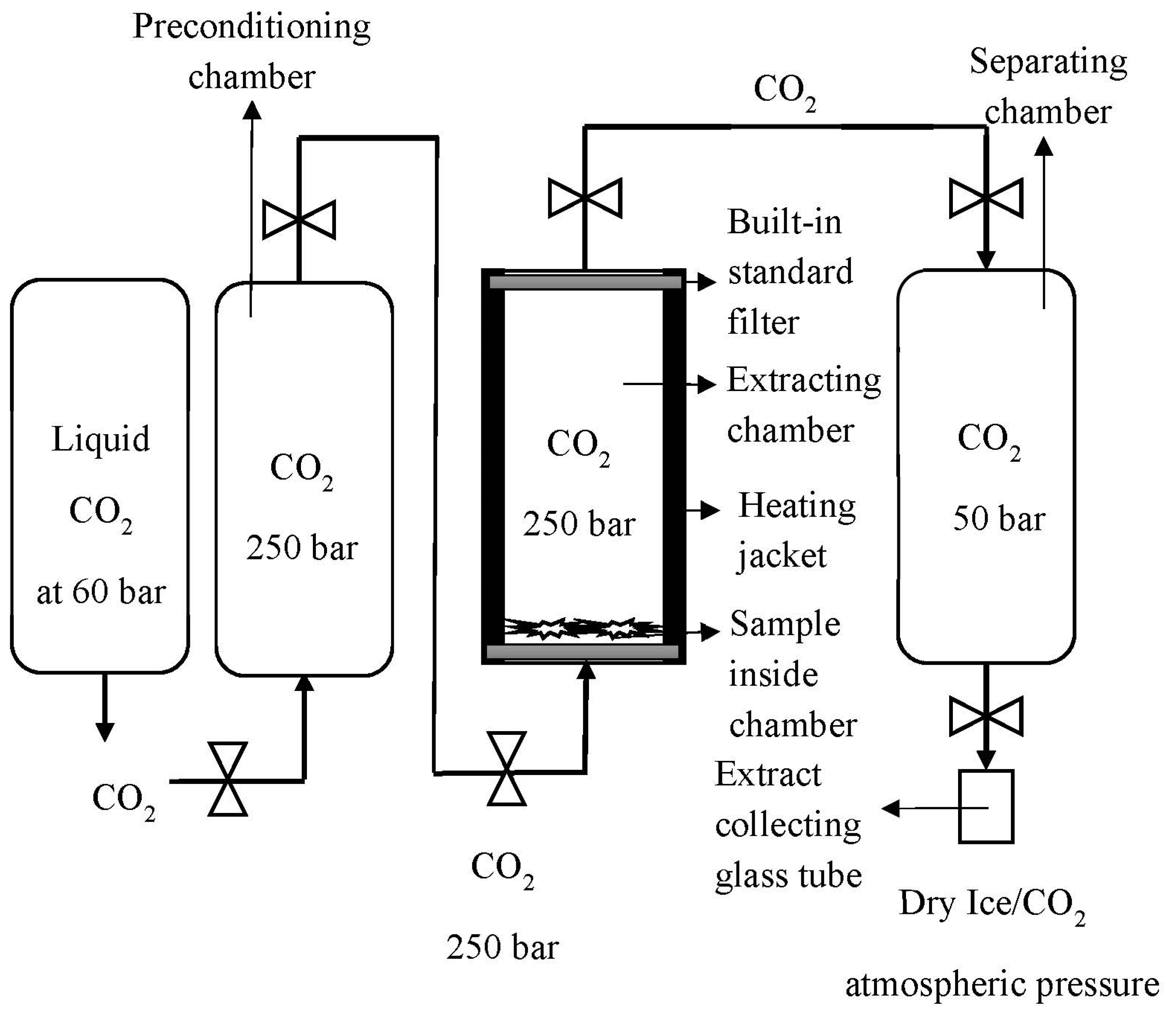
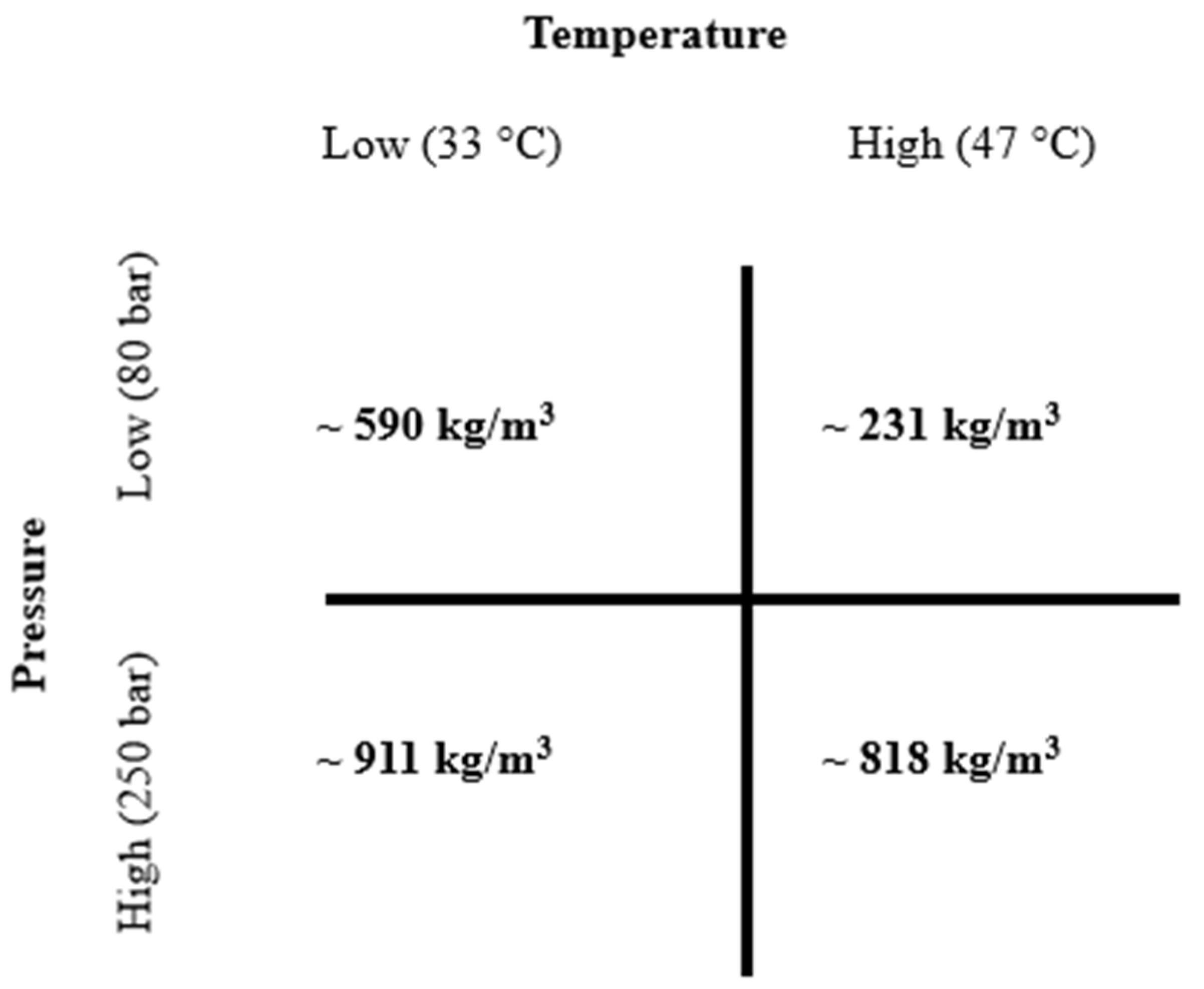
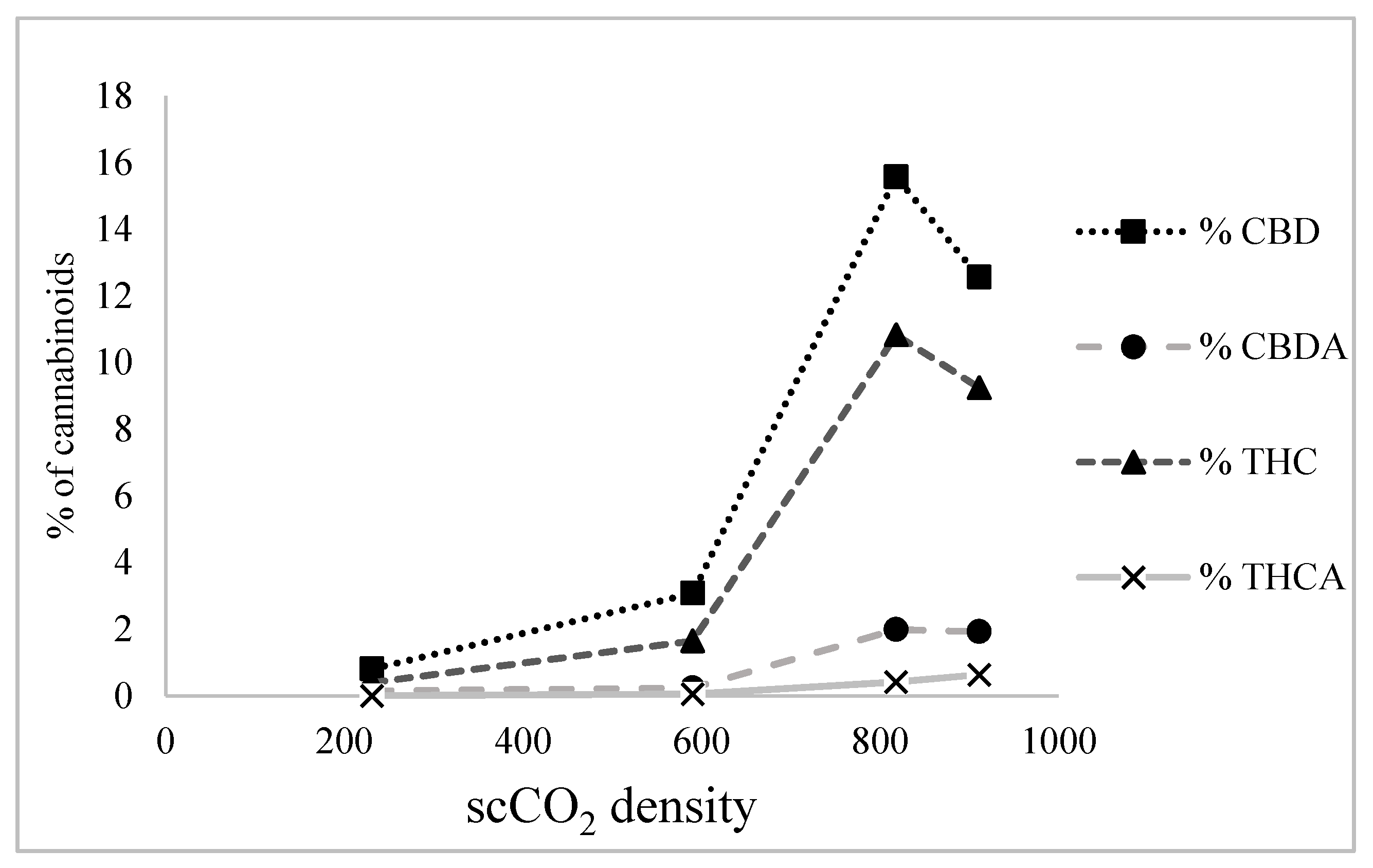
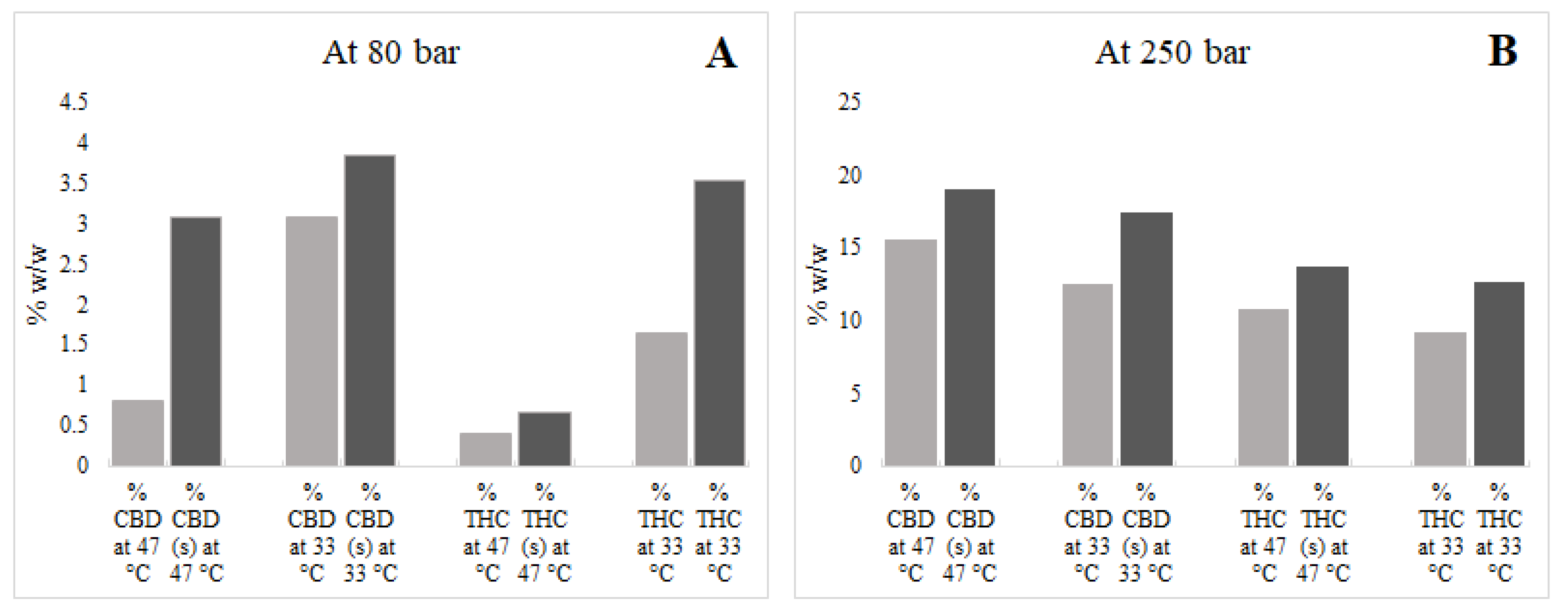
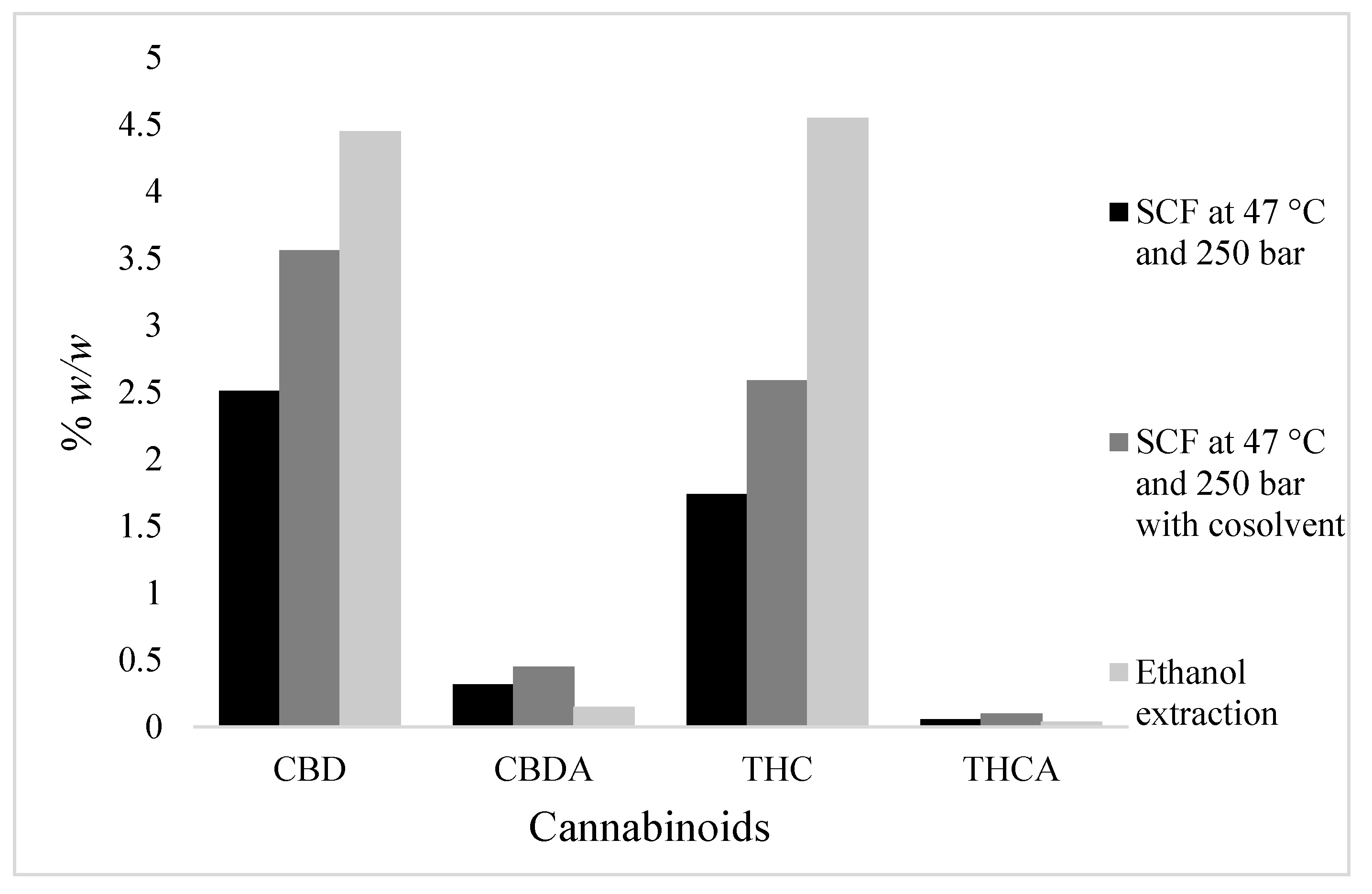

| Compound/Variety | CBD | CBDA | D9-THC | D9-THCA | |
|---|---|---|---|---|---|
| Cannabis native | Cannabinoids extracted from cannabis sample (% w/v) | 0.73 ± 0.01 | 6.33 ± 0.13 | 0.79 ± 0.01 | 5.02 ± 0.09 |
| Cannabinoids in ethanol extract (% w/v) | 2.05 ± 0.01 | 17.79 ± 0.05 | 2.22 ± 0.00 | 14.11 ± 0.13 | |
| Cannabis decarb | Cannabinoids extracted from cannabis sample (% w/v) | 4.50 ± 0.04 | 0.15 ± 0.02 | 4.65 ± 0.24 | 0.04 ± 0.01 |
| Cannabinoids in ethanol extract (% w/v) | 12.65 ± 0.13 | 0.42 ± 0.00 | 13.10 ± 0.02 | 0.11 ± 0.00 | |
| Plot 1 | ||||
| Temperature (°C) | 47 | |||
| scCO2 density (kg/m3) | 231 | |||
| scCO2 extraction yield (% w/v) | 6.07 | |||
| scCO2 with co-solvent extraction yield (% w/v) | 7.56 | |||
| Cannabinoids | ||||
| CBD | CBDA | THC | THCA | |
| Cannabinoids in scCO2 extract (% w/v) | 0.81 ± 0.04 | 0.15 ± 0.01 | 0.40 ± 0.03 | 0.00 ± 0.00 |
| Total cannabinoids extracted from cannabis sample (% w/v) | 0.05 ± 0.00 | 0.01 ± 0.00 | 0.02 ± 0.00 | 0.00 ± 0.00 |
| Total cannabinoids in scCO2 extract with co-solvent extract (% w/v) | 1.35 ± 0.05 | 0.18 ± 0.01 | 0.65 ± 0.02 | 0.06 ± 0.01 |
| Total cannabinoids extracted from cannabis sample (% w/v) | 0.10 ± 0.01 | 0.01 ± 0.00 | 0.05 ± 0.00 | 0.00 ± 0.00 |
| Plot 2 | ||||
| Temperature (°C) | 33 | |||
| scCO2 operating density (kg/m3) | 590 | |||
| scCO2 extraction yield (% w/v) | 6.74 | |||
| scCO2 with co-solvent extraction yield (% w/v) | 9.44 | |||
| Cannabinoids | ||||
| CBD | CBDA | THC | THCA | |
| Cannabinoids in scCO2 extract (% w/v) | 3.08 ± 0.06 | 0.24 ± 0.00 | 1.65 ± 0.03 | 0.05 ± 0.00 |
| Total cannabinoids extracted from cannabis sample (% w/v) | 0.21 ± 0.00 | 0.02 ± 0.00 | 0.11 ± 0.00 | 0.00 ± 0.00 |
| Total cannabinoids in scCO2 extract with co-solvent extract (% w/v) | 3.83 ± 0.29 | 0.69 ± 0.04 | 3.54 ± 0.29 | 0.20 ± 0.01 |
| Total cannabinoids extracted from cannabis sample (% w/v) | 0.36 ± 0.01 | 0.07 ± 0.00 | 0.33 ± 0.02 | 0.02 ± 0.00 |
| Plot 3 | ||||
| Temperature (°C) | 47 | |||
| scCO2 operating density (kg/m3) | 818 | |||
| scCO2 extraction yield (% w/v) | 16.1 | |||
| scCO2 with co-solvent extraction yield (% w/v) | 18.17 | |||
| Cannabinoids | ||||
| CBD | CBDA | THC | THCA | |
| Cannabinoids in scCO2 extract (% w/v) | 15.57 ± 0.40 | 1.99 ± 0.05 | 10.83 ± 0.26 | 0.41 ± 0.01 |
| Total cannabinoids extracted from cannabis sample (% w/v) | 2.51 ± 0.03 | 0.32 ± 0.04 | 1.74 ± 0.03 | 0.06 ± 0.00 |
| Total cannabinoids in scCO2 extract with co-solvent extract (% w/v) | 19.05 ± 0.43 | 2.47 ± 0.05 | 13.73 ± 0.24 | 0.54 ± 0.01 |
| Total cannabinoids extracted from cannabis sample (% w/v) | 3.46 ± 0.22 | 0.45 ± 0.03 | 2.49 ± 0.04 | 0.10 ± 0.00 |
| Plot 4 | ||||
| Temperature (°C) | 33 | |||
| scCO2 operating density (kg/m3) | 911 | |||
| scCO2 extraction yield (% w/v) | 16.13 | |||
| scCO2 with co-solvent extraction yield (% w/v) | 17.98 | |||
| Cannabinoids | ||||
| CBD | CBDA | THC | THCA | |
| Cannabinoids in scCO2 extract (% w/v) | 12.56 ± 0.21 | 1.93 ± 0.02 | 9.24 ± 0.17 | 0.63 ± 0.03 |
| Total cannabinoids extracted from cannabis sample (% w/v) | 2.03 ± 0.02 | 0.31 ± 0.00 | 1.49 ± 0.03 | 0.10 ± 0.00 |
| Total cannabinoids in scCO2 extract with co-solvent extract (% w/v) | 17.47 ± 0.61 | 2.41 ± 0.08 | 12.59 ± 0.67 | 0.60 ± 0.02 |
| Total cannabinoids extracted from cannabis sample (% w/v) | 3.14 ± 0.33 | 0.43 ± 0.04 | 2.26 ± 0.23 | 0.11 ± 0.00 |
Publisher’s Note: MDPI stays neutral with regard to jurisdictional claims in published maps and institutional affiliations. |
© 2021 by the authors. Licensee MDPI, Basel, Switzerland. This article is an open access article distributed under the terms and conditions of the Creative Commons Attribution (CC BY) license (https://creativecommons.org/licenses/by/4.0/).
Share and Cite
Qamar, S.; Torres, Y.J.M.; Parekh, H.S.; Falconer, J.R. Effects of Ethanol on the Supercritical Carbon Dioxide Extraction of Cannabinoids from Near Equimolar (THC and CBD Balanced) Cannabis Flower. Separations 2021, 8, 154. https://doi.org/10.3390/separations8090154
Qamar S, Torres YJM, Parekh HS, Falconer JR. Effects of Ethanol on the Supercritical Carbon Dioxide Extraction of Cannabinoids from Near Equimolar (THC and CBD Balanced) Cannabis Flower. Separations. 2021; 8(9):154. https://doi.org/10.3390/separations8090154
Chicago/Turabian StyleQamar, Sadia, Yady J. M. Torres, Harendra S. Parekh, and James Robert Falconer. 2021. "Effects of Ethanol on the Supercritical Carbon Dioxide Extraction of Cannabinoids from Near Equimolar (THC and CBD Balanced) Cannabis Flower" Separations 8, no. 9: 154. https://doi.org/10.3390/separations8090154




